
Shoppers Feedback:
Jan 17, 2017
Hello Ros,
I have now paid the invoice, but I would like to write to you just to say a big THANK YOU for getting me the Penguin!
The ChatterMate Penguin became a nice memory for me when I was in New Zealand, and I am so greatful to you for arranging so that I could have it! :-)
Thank you so much!!!!!!!!!!!
Regards,
Malin
Hi Ros,
Many thanks for your very kind email. I really appreciate your prompt reply!
I appreciate your advice regarding the decorations and customs. These are a gift for my daughter’s exchange student family so when she returns home on the weekend I will show her and see if she loves them as much as I do!
Thanks so very much again - I am truly grateful for your kind assistance.
Kind Regards
Bernadette
Ros,
Thanks again for the great customer service. It's a refreshing change!
Best regards,
Trevor
Hey Roz,
Thank you for your emails. Just loved my first order. The cute little Aussie bush critters are going to be used for an office Christmas decoration. My colleagues also liked them and talked about making an order to your site. I'll send you a photo when completed.
I'll be ordering more to send to my daughter's host family in America.
Fabulous service from you.
Kind regards,
Michelle
Thankyou. Order arrived today. One very happy grandson with his new beastly binoculars.
Regards,
Irene
- Home
- Wild Wonders
- Shop
- Aromas of Australia
- Australian Made
- Books
- Book Marks
- Christmas Decoration Sale
- Christmas Decorations
- Clocks
- Drink Holders
- Garden & Outdoor
- Gift Wrapping & Cards
- Home & Giftware
- Jewellery
- Keyrings
- New Products
- Pencils & Pen Holders
- Photo Frames
- Plush Toys
- Plush with Sound
- Sheepskin Rugs
- Stationery
- Stone Carvings
- Toys & Games
- Travel Goods
- Wedding
- Wild Figurines
- Wildlife Safety Products
- Wind Chimes
- Wine Charms
- View All Products
- Wildlife
- Australiana
- Explore
- Contact Us
Tips for Avoiding Wildlife Collisions
Exploring Australia by Road - a fantastic way to see and experience this amazing country.
The benefits of taking yourself exploring by road is that you can go wherever you like, you see and experience what you like and you can stop whenever you like! When I see something anytime I'm travelling and I'll stop to check it out - whether it's one of our incredible wildlife species, a beautiful sight over our sparkling oceans or a view that you can get lost in from on top of our mighty mountain ranges or even to stop and grab a cuppa in the many unique towns along the way.
Plus you get to meet some real characters who can often point out special places of interest that are possible not in tourist brochures.
Travel safe and maybe we'll meet on the road!
Driving In Australia - Test your Driving Knowledge
Are you coming to Australia on holiday? Practicing your Driver's Knowledge Test (DKT) online is easy and free right here and can aid you hiring vehicles while in Australia. These 77 questions are the essential road rules you'll need to know to help you stay safe and minimise your chance of an accident. Test your driving knowledge
Avoid Fatigue - use a Pit Stop Planner
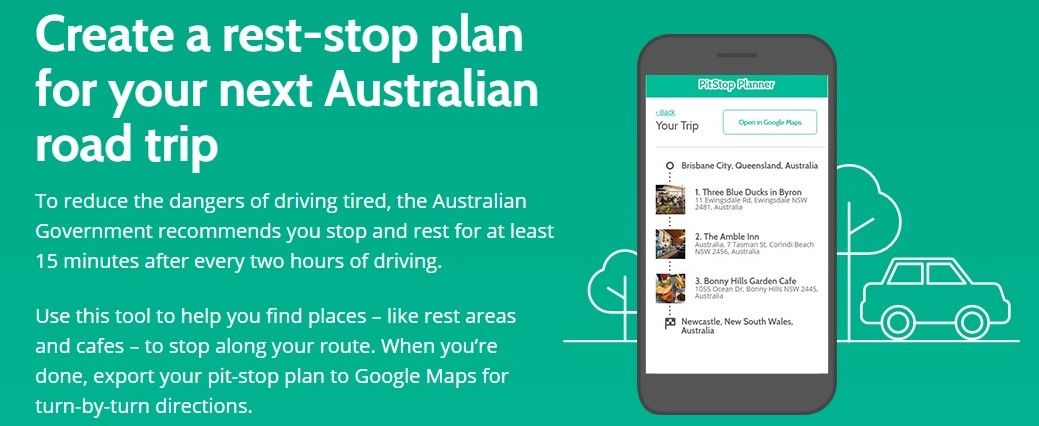 The Australian Government and Driver Reviver program recommend stopping every 2 hours for at least 15 minutes to avoid fatigue. Aussies have all heard the stats on driver fatigue related crashes and fatalities at one point or another. However, each holiday period there is a spike in these crashes, so it seems drivers need a little reminder to stop and rest. Plan your trip and rest stops - Map out your trip and break it down into smaller chunks to ensure sufficient fuel stops, avoid late night driving and dangerous roads. Use a tool like this Pit Stop Planner to make sure you stop and take a rest regularly to avoid fatigue and take in the sights. Driving when well rested also helps keep us alert for wildlife suddenly appearing on roads.
The Australian Government and Driver Reviver program recommend stopping every 2 hours for at least 15 minutes to avoid fatigue. Aussies have all heard the stats on driver fatigue related crashes and fatalities at one point or another. However, each holiday period there is a spike in these crashes, so it seems drivers need a little reminder to stop and rest. Plan your trip and rest stops - Map out your trip and break it down into smaller chunks to ensure sufficient fuel stops, avoid late night driving and dangerous roads. Use a tool like this Pit Stop Planner to make sure you stop and take a rest regularly to avoid fatigue and take in the sights. Driving when well rested also helps keep us alert for wildlife suddenly appearing on roads.
Driving Amongst Wildlife - Night Driving
Watch Out! for Wildlife! Whenever possible, do not drive at night outside of towns and major cities. A lot of Australian Wildlife comes out at night - especially kangaroos. Kangaroos move around more at night than they do in the day. Dawn and Dusk are the times to really be on the lookout.
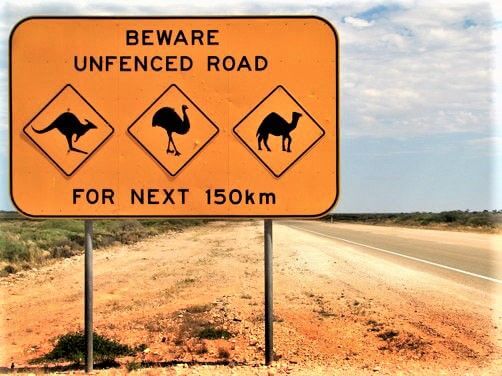
During the drought in Australia, animals are known to wander into towns in search of food and water, so be on the lookout at all times. In really bad droughts and hot summers, it is not uncommon to find wildlife in towns - some towns have large animals are birds living in their towns all year round such as kangaroos, emus and cassowaries so always Watch Out! for wildlife.
The animals that are more common on the Australian roads are Kangaroo, Echidna and Wallabies. Other animals that you might come across are Emus, Eagles and other birdlife, wandering Cattle, Camels, and Brumbies (Wild Horses).
In the outback, be especially careful of wandering stock that move onto the roads at night to sleep. The outback can get very cold at night time and the roads are still warm, so the cattle move to the warm roads to sleep.
In areas such as the Daintree in Northern Queensland - be aware of Cassowaries - there are less than 1500 left in the wild and they are often sighted crossing roads. Slow down in the areas of the Cassowaries, the areas are well signposted so please be Cass - o - wary.
Many areas that are high traffic areas for wildlife are well signposted - but remember, wildlife can't read so it doesn't always stay between the signs!
One of the best things about driving through Australia is seeing wildlife along the way.
Tips to Help Avoid a Collision with Wildlife 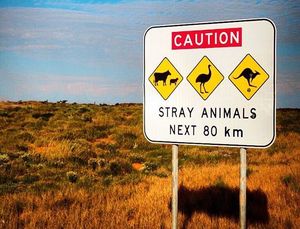
As obvious as this is, remember you are driving in Australia and not only do we have to watch for wildlife while driving but wandering stock as well.
Not all wildlife and vehicle collisions are in the country areas. Major cities of Australia are known to have wildlife and vehicle collisions too so stay alert at all times in all areas. Watch the roadsides and into the paddocks as well.
Wildlife use natural corridors to move around as well. What are wildlife corridors? Glad you asked! Wildlife corridors are connections across the landscape that join up areas of habitat, they help species move from shelter to food, to water, and even to find a mate.
Avoid Dawn and Dusk
 Try to avoid driving at dawn and dusk and for the first couple of hours after it gets dark where animals live as this is when the animals are generally more active and move around more to feed. If the locals tell you to be off the road before dark - I recommend you take their advice! But remember, wildlife is active during the daylight hours too so always Watch Out! for wildlife.
Try to avoid driving at dawn and dusk and for the first couple of hours after it gets dark where animals live as this is when the animals are generally more active and move around more to feed. If the locals tell you to be off the road before dark - I recommend you take their advice! But remember, wildlife is active during the daylight hours too so always Watch Out! for wildlife.
Be Alert - Wildlife Warnings
Be Alert in any areas that may have wildlife or are signposted that animals are in the area, such as open country roads and national parks. Take notice of wildlife warning signs. These 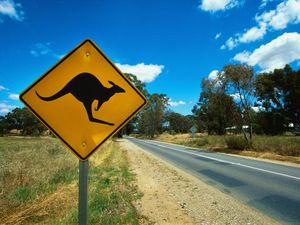 are generally placed in areas of high populations of wildlife. Signs may have just a kangaroo on them, but there could also be other wildlife species in the area. Pay close attention to these signs and be aware that wildlife can't read and don't always stay between the signs.
are generally placed in areas of high populations of wildlife. Signs may have just a kangaroo on them, but there could also be other wildlife species in the area. Pay close attention to these signs and be aware that wildlife can't read and don't always stay between the signs.
Slow Down
When you drive slower in poor visibility, where bushland comes right up to the edge of the road or where animals are known to roam, will give you a better chance of avoiding a collision with an animal - which can save the life the animal and possibly injury to you and damage to your vehicle.
High Beam
Whenever you can when driving, use your high beam lights so that you can see the sides of the roads better and further down the road at night. Be aware, that animals can be dazed by bright lights and may not move off the road. Dip your headlights - do not flash the lights, and if possible - slow down and sound your vehicle horn as soon as you sight the animal. This may give the animal a chance to move off the road.
Your Own Safety
Your Own Safety should always come first. When you come across an animal in the path of your vehicle, your natural instinct may be to swerve to miss hitting it. But, this can put you, your passengers, and other motorists in danger. Always keep full control of your car, unfortunately, sometimes it might not be possible to miss an animal.
Animals Need Time
Animals can often be very unpredictable. Whenever possible, brake gently and give them time to move off the road. Always keep an eye out for more animals. With Kangaroos, where there is one, there is often more. Always when passing an animal, be aware that they may come back across the path of your vehicle and that there may be other animals.
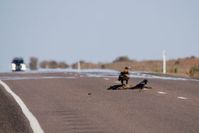
If you see a dead animal by the roadside, honk your vehicle horn as early as you see the dead animal. This can sometimes scare off any eagles, other birds of prey, dingoes, and any other animals feeding on it so that they don't become another roadkill victim alongside the animal they were feeding on. Unfortunately, this is a common problem.
To really help our wildlife that feeds by scavenging, remove the dead animal from the road. Animals feeding on roadkill often fall victim to collisions with vehicles as they cannot always move away from their food source quickly enough and often move into the path of the oncoming vehicle in a panic.
Carry disposable plastic gloves to do this - keep the gloves after use and dispose of in the next available rubbish bin.
Injured Animals
Often on the roads where animals are present, signs are put up with phone numbers to call for help if wildlife is injured. When you come across these signs, put the details into your mobile phone, you may just need them one day, or another motorist might. An easy way to grab a number on the go is to take a photo of the sign with your mobile camera or digital cameras as you can pull up the photo if needed at any time.
Don't Litter!
It is against the law to throw anything from a vehicle. 
Throwing food scraps and rubbish that has had food in it out of your car is not only illegal, but it can attract wildlife to feed on the scraps on the roads, which increases the chances of them being injured or killed and makes the roadsides unpleasant to look at.
Take a bag in the car for your rubbish and put it in a bin when you find one.
Keep Australia Beautiful and Help Protect Our Wildlife
BUSH e-TELEGRAPH
Signup for our monthly newsletter the "e-Telegraph"
Quick Links
Home | The Beginning | About The Land Down Under | Wild Wonders | Advertise on Wild Wonders | Christmas Decoration Sale | Christmas Tree Decorations | Drink Holders | Plush with Sound | Stone Carvings | Wildlife Wine Charms | Freebies | Australian Wildlife | Help Our Wildlife | Australiana | Photo of the Month | Explore The Land Down Under | Contact Us | Legal Notices
